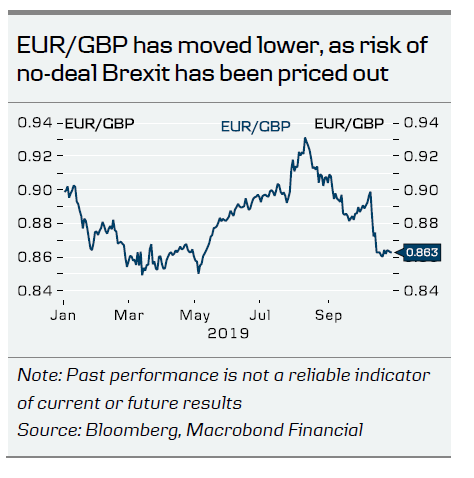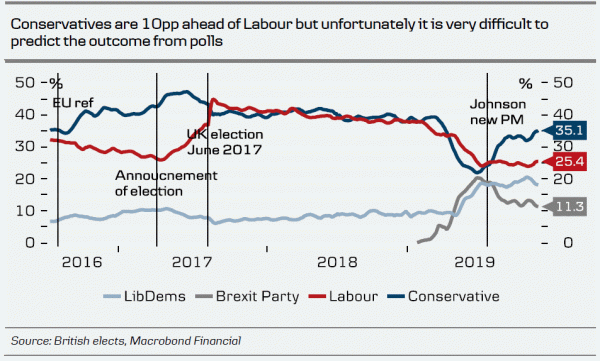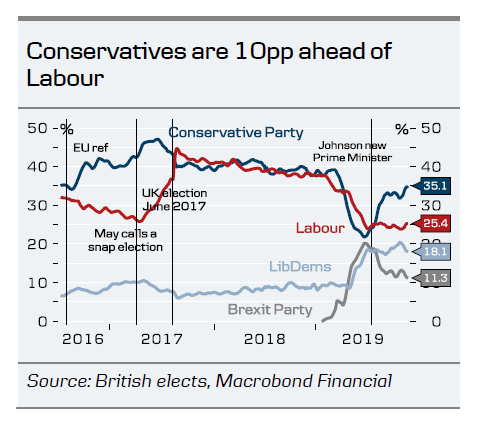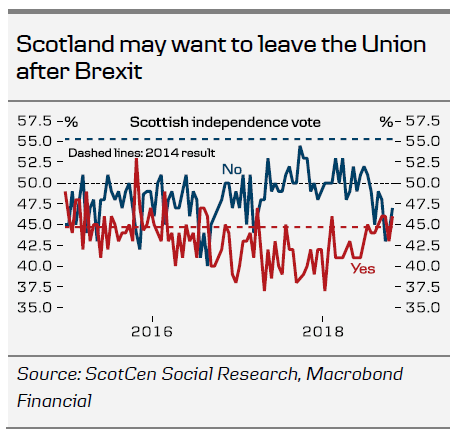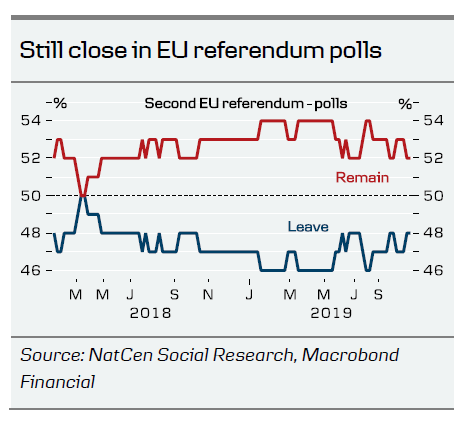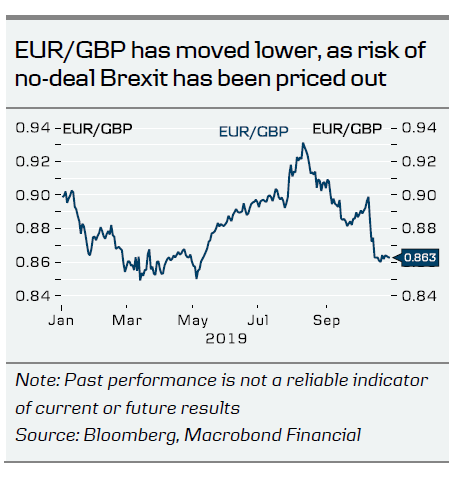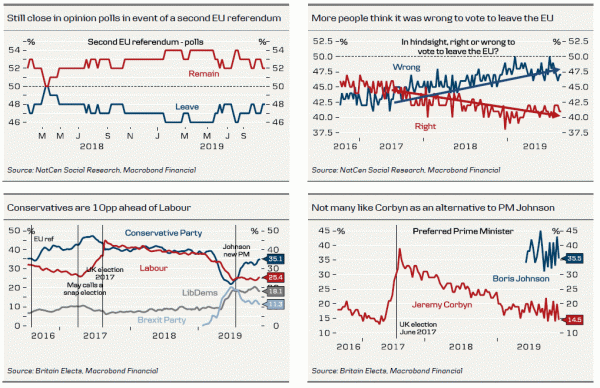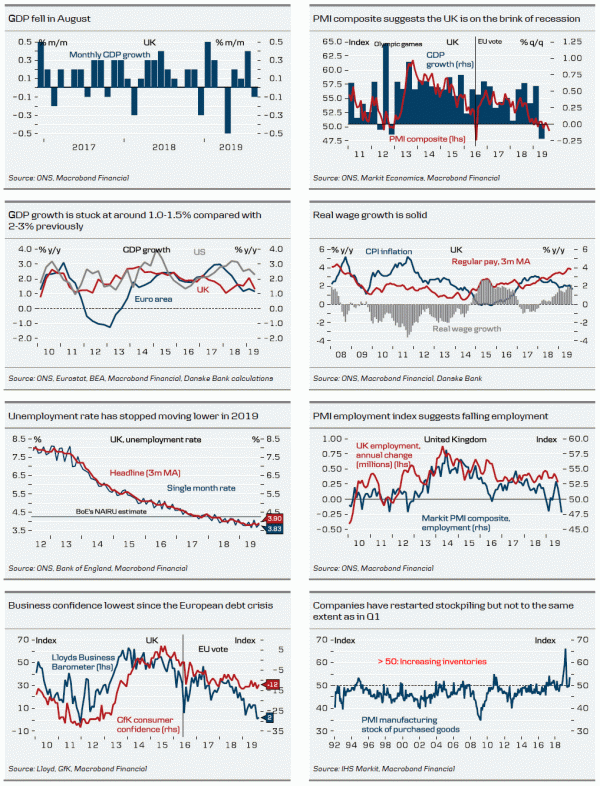Election result is now what matters
In line with our long-held view Brexit has been extended (new Brexit Day is 31 January 2020) and a general election is called (Election Day 12 December). In our view, the election is an EU referendum in disguise. PM Johnson will campaign on his ‘Get Brexit Done’ platform arguing the public should give him the mandate to implement his Brexit deal. LibDems, SNP, Plaid Cymru and Greens are likely to campaign for a second EU referendum (with ‘remain’ as an option on the ballot). It is more difficult to say what platform Labour is campaigning, as Labour in reality has not clarified its position on Brexit. However, we would expect Labour to back a second EU referendum eventually.
This means we may soon get to the Brexit end game, unless we get a (very?) hung parliament without a clear/stable majority, like we did in 2017. If this is the case, the period of high uncertainty and confusion will continue and the UK may need another extension beyond 31 January.
Overall, the tail risk of a no-deal Brexit has declined substantially and investors have priced out a lot of negativity in GBP. The election does not change this (see page 3).
Unfortunately, it is difficult to translate polls into mandates due to the ‘winner takes all’ election system (see appendix on page 4 for more details). Just to illustrate, the Conservatives won 13 seats in Scotland in the 2017 election but it seems difficult for Johnson to win more than a few Scottish seats in an election now (see e.g. The Times, 7 September). This also means we do not have a clear view as of today what outcome is most likely. The election results in 2015 and 2017 caught most by surprise.
The Conservative Party’s support has surged (at the expense of The Brexit Party) since Boris Johnson took over as Prime Minister. As a result, most seat projections indicate an absolute majority for the Conservatives but one should not put too much weight on these.
The seat projections were way off in 2017 (see Institute for Government) except for the YouGov election model, which was the only one that predicted the Conservatives would lose the absolute majority. The latest update is outdated but hopefully we will get more regular updates of the model now the election is called. One of the problems for the projections last time was that the turnout was higher than expected (68.8% versus 66.2% in 2015) and the highest since 1997.
Scenario 1. Conservatives win solid absolute majority
A solid majority win for the Conservatives would mean PM Johnson would implement his Brexit deal without too many problems. Even a slim majority may also prove sufficient, as long as Johnson achieves independence from the DUP and The Brexit Party. Prime Minister Johnson would become more powerful, as winning elections is what politics is all about. At the same time, some of the excluded Conservative rebels will no longer sit as MPs, making life easier for Johnson. In other words, the Conservative MPs will become more loyal. Focus will instead turn to the negotiations with the EU on the future relationship, where another type of ‘no-deal’ Brexit looms by the end of the transition period if no agreement is reached.
Looking beyond Brexit, Johnson’s economic policy may also attract attention, as he has pledged to lower taxes and increase spending. We do not know many details yet but based on what we do know, it may be a significant fiscal boost to growth (and, hopefully, productivity growth down the road, depending on what Johnson spends the money on).
We also see a high risk of a second independence referendum in Scotland in coming years after the UK has left the EU (support for Scottish independence is increasing due to Brexit). Further out, we may even see a unification referendum in Northern Ireland, as Northern Ireland is treated differently from the rest of the UK.
Scenario 2. Labour + Liberal Democrats + SNP + Plaid Cymru + Greens win the majority
While it would not be easy for the five parties to co-operate, the parties are more pro-EU and have indicated they want a second EU referendum with ‘remain’ as an option. Labour is most sceptical, as it wants to negotiate its own Brexit deal first, which should be included on the ballot paper. Whether this will be the case depends on the strength of the individual parties. The stronger the Liberal Democrats are, the higher the likelihood of a second EU referendum.
We think a second EU referendum with ‘remain’ as an option is almost certain in this scenario. Looking at recent EU referendum polls, ‘remain’ is still slightly ahead but it is a close call, not least taking into account that polls were at least somewhat biased towards ‘remain’ ahead of the 2016 vote. The question is what alternative to ‘remain’ is set to appear on the ballot paper.
Following an EU referendum, it is difficult to see such a coalition being able to survive and we may head for another general election.
In our view, it is highly unlikely Labour will get an absolute majority by itself, not least because the Labour Party is polling badly in Scotland. If we are caught by surprise, markets will not only focus on Brexit but also on Labour’s overall economic policy.
Scenario 3. Hung parliament with no stable majority
We may end up with a hung parliament without a clear/stable majority for any party or coalition of parties (or the parties refuse to, or are unable to, work together in coalitions). In this scenario, it is difficult to predict what would happen. It is likely that another extension beyond 31 January would be needed in this scenario.
Despite no political stability, we think the likelihood of a no-deal outcome is still low in this scenario. Either the UK will likely ask the EU for another extension (with the risk of the EU rejecting it, which we doubt despite Brexit fatigue) or a majority of Conservatives and Labour Brexiteers will eventually pass something like PM Johnson’s deal (or former PM May’s deal).
FX. EUR/GBP is set to trade in the 0.85-0.90 range
Near term and during election campaigning we regard GBP a tad vulnerable given the recent pricing out of no-deal Brexit risk. However, the snap election was largely expected and, as such, should not provoke a major GBP reaction.
We expect EUR/GBP to trade in the 0.85-0.90 range ahead of Election Day and thus envisage some GBP downside from current spot levels.
Needless to say, if polls indicate a clear shift towards one of the sketched scenarios GBP would react.
- Scenario 1 (Conservative majority) should not be able to take GBP markedly outside of the range around 0.875 but could see EUR/GBP moving to the lower end of the range.
- Scenario 2 (opposition wins) would spur hopes of Brexit being undone and should thus support GBP with a break below 0.85 likely.
- Scenario 3 (hung parliament) should be GBP negative in creating renewed political uncertainty but upside in EUR/GBP likely still capped around 0.90.
Appendix. UK election system
Each of the 650 constituencies elects one Member of Parliament by the so-called ‘first past the post’ system, where the candidate with most of the votes (not necessarily the majority of the votes) takes the seat (‘winner takes all’). This election system benefits the big parties and explains why The Conservative Party and The Labour Party have taken turns leading the government. This has been breaking up more recently with hung parliaments (i.e. no party with absolute majority by itself) following the 2017 and 2010 elections. The ‘winner takes all’ system also means there is a higher degree of tactical voting, as there is a high risk of a wasted vote. If Party A gets 30%, Party B gets 30% and Party C gets 40%, then the candidate from Party C wins the seat. However, if Party B’s voters vote for Party A instead, Party A wins the mandate. This explains why the Scottish National Party (SNP) has many MPs, while its share of the national vote is small.
The magic number for a majority is 326 seats but in practice the number is a little lower, as historically the seven Sinn Fein (the Irish Republican Party) MPs have not taken their seats. The number of mandates for Sinn Fein changes from election to election.
The Fixed Term Parliament Act of 2011 introduced fixed-term elections with an election every fifth year with two exceptions (1) the House of Commons dissolves itself by a twothirds majority or (2) the government loses a no-confidence vote and no new government is formed within two weeks.
A person is eligible to vote only if he/she is a registered voter, which usually explains why historically the turnout among young voters has been low.
Polling stations are open from 08:00 CET to 23:00 CET. Exit polls are released when polling stations are closed. We usually know the election results early in the morning of the following day.




